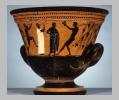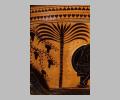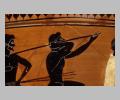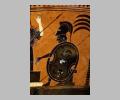| Collection: | Toledo Museum of Art |
| Summary: | Side A: Achilles and Ajax playing a board game. Side B: Athletes and trainers. |
| Ware: | Attic Black Figure |
| Painter: | Attributed to the Rycroft Painter |
| Date: | ca. 520 BC - ca. 515 BC |
| Dimensions: | H. 39.2 cm; d. at rim 46.5 cm. |
| Primary Citation: | |
| Shape: | Calyx krater |
| Beazley Number: | 351102 |
| Period: | Archaic |
Condition: Black glaze misfired to red and green in places.
Decoration Description:
Side A: Achilles and Ajax playing a board game. The heroes are seated at a low, wide, gaming table, flanked by palm trees. They are fully armed, but apparently at rest: each carries a spear in his left hand and has slung his shield over his left shoulder. Both wear Corinthian helmets, perched on top of their heads like hats; Achilles' helmet has a high crest, Ajax's a low one. Both heroes are mature bearded men. Achilles wears a short chiton, a chlamys and greaves. Ajax's body is mostly obscured by his Boeotian shield, its device a frontal panther's head between snakes. Achilles is about to make a move with his carefully poised right hand; Ajax gestures, his right hand extended, palm toward the viewer. Athena stands at center, behind the gaming table, her presence not noted by the players. Her upper torso is in front view and her legs turn right, but the goddess looks around towards the left. She wields a spear in her right hand and gestures with her raised left hand to warn the players of the approaching enemy. Athena wears an Attic helmet, and a chiton, topped by an aegis bearing a large gorgoneion. Side B: athletes and their trainers. To the right of center a musician (r.) plays the double flute (aulos). At the far left stands a trainer (r.); an athlete (l.) carrying three javelins in his left hand, walks toward him, but turns back to look at the other figures. An acontist (r.) rushes toward the center as he throws his javelin. On the far fight, an athlete (l.) prepares to jump with weights (halteres), and a trainer (l.) turns back to look at him. The musician wears a long white robe and a wreath on his head. The trainers wear himatia and carry staffs. The hair of the trainer on the left, as well as that of each athlete, is bound by a fillet. The left-hand trainer is a youth. The raised arm of the acontist obscures the lower part of his face. All other figures are bearded. At the handles: grape vines. A vine of ivy encircles the exterior below the rim, and a tongue pattern encircles the lower part of the body. Interior glazed black save for reserved stripe near rim. Added red: interior of Achilles' shield, fold of fabric at his waist, pattern on Ajax's helmet, dots on chiton of Athena, and on himation of youthful trainer, borders of chiton of Athena and of himation of mature trainer, most beards, fillets, inscriptions, stem of ivy pattern and alternate tongues. Added white: edge of Achilles' shield, Ajax's shield device, base of gaming table, Athena's flesh and her gorgoneion, musician's robe.
This impressive pot, large in size and sturdy in shape, was well designed for its function. The ancient Greeks diluted their strong wine so that its aroma and consistency became suitable for drinking. Kraters generally served as mixing bowls for cutting wine with water. Occasionally, when filled with snow or ice water they became wine coolers—receptacles for smaller vases, psykters (see
The body of the Toledo krater has a cup-shaped bottom from which the walls of the vase rise, slowly spreading outward toward the top. In form it is like the calyx of a flower; hence derives the name by which the shape is now known. The master painter and potter Exekias is credited with the invention of this type of krater. Around 520 B.C. he decorated the earliest preserved example, found on the North Slope of the Athenian Acropolis (Hesperia 6 [1937] 469-486).The calyx-krater was a late comer to the repertory of black-figure workshops. The Toledo vase is the only black-figured calyx-krater in a Midwestern collection. Its careful artist, the Rycroft Painter, appears to have worked solely in black-figure, but Beazley considered him "related to Psiax" (
The Rycroft Painter's calyx-krater departs from the ornamental scheme of Exekias' North Slope vase. A vine of ivy appears in the reserved band below the rim, instead of a palmette-lotus-chain. A tongue pattern replaces Exekian rays. The cul (convex-curved lower zone) is plain—painted black; on Exekias' calyx-krater it is decorated with a figurative predella. Significantly, this alternative black-figure scheme (cf. (supra). In red-figure, the calyx-krater is a dark vase with light decoration; the Exekian black-figure type is light with dark decoration. The Toledo calyx-krater comes between the two; it is partly a light vase and partly a dark vase.
The depiction on the obverse recalls another famous prototype by Exekias (cf.
The palaestra scene (
Inscriptions:
The names of the characters in the gaming scene are inscribed. Written notation of which player is which hero is not common (
Essay:
Collection History: Ex collection S. Schweizer.
Sources Used:
Other Bibliography:





